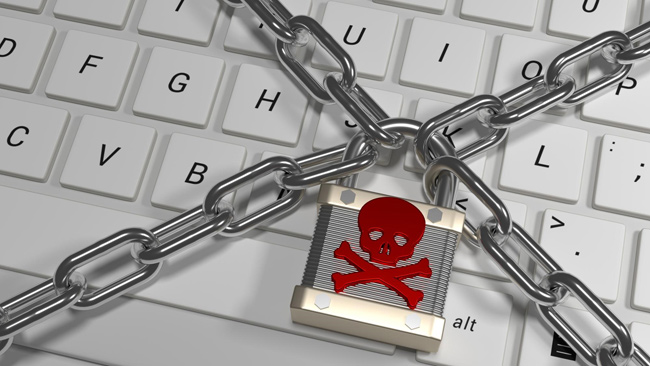When a ransom message with demands flashes on your screen, it’s too late.
Threat actors have already gained access to a device and installed malware that locks files.
This means you are locked out of your computer until the ransom is paid.
However, even if your company gives in to hackers’ demands, there is no guarantee you’ll regain access to files or the entire system or that sensitive data won’t be leaked.
This could mean having to rebuild the entire infrastructure, wasting a lot of time dealing with the aftermath of the attack, getting behind with work, and allocating resources to patching up flaws that enabled ransomware.
What can you do to secure your company’s systems?
We’ll go over steps that you can take to prevent and prepare for a ransomware attack attempt.
Start With Awareness Training
Most ransomware attacks in the past have been the result of a social engineering attack such as phishing.
Criminals target unsuspected people that work within a company because they know that humans are the weakest link when it comes to cybersecurity.
Protecting the company may not be their primary role, and as they’re crossing off their daily to-do lists, they may click on a link that downloads malware to the PC.
To prevent this from happening, introduce basic cybersecurity training for company employees.
The training session should raise awareness on how to recognize the signs of ransomware, what to do if the criminals demand ransom, how to set up strong passwords, how to recognize the most common phishing attempts and more.
Back-Up All Essential and Sensitive Data
When a ransomware attack hits, a company might lose access to some of its most critical files or the entire infrastructure. The extent will depend on the criminal’s hacking skills and the type of ransomware they use.
Create backups of files that are essential for employees to do their jobs, as well as those that contain sensitive information.
In that way, even if they get locked out of devices, teams can continue to work until the issue is resolved.
To protect sensitive information, some companies have systems that let them know where such data is at all times and even isolate it on physical servers that are more difficult to hack.
Create Strong Passwords
Regular changes of user credentials can go a long way in ransomware prevention. To install any malware (ransomware) to your device, hackers have to get access to a device.
One way that criminals can get to the files is by using stolen employee credentials or by guessing weak passwords.
If people tend to reuse their credentials for multiple accounts, this means that hackers can access all accounts that permit access with that same password.
A few tips for strengthening login credentials include:
- Avoid reusing any old passwords — if you have trouble remembering them, use a password manager instead
- Change the password regularly — at least every three to six months
- Have a password that consists of at least ten versatile characters — a mix of signs, lowercase, and uppercase letters, and numbers
- Avoid having the words that are in the dictionary in your password string
- Don’t include any personal information as part of your password — such as pet names, births, addresses, names
Tips and tricks on setting up a strong password can also be a part of the basic cybersecurity awareness training.
Keep Your Systems Updated
Every company relies on versatile services, applications, and software for daily work. Ensuring regular updates of the software and tools you use means that you’re using the safest version of it currently available.
The truth is, technology can have new vulnerabilities at any time.
When security teams discover them, they patch them up. All you have to do is update your systems to the latest patched-up version that vendors have released to protect their users.
Introduce Strong User Authentication
As mentioned, hackers need to gain access to your devices to perform ransomware. One way to obtain remote access to your systems is via the Remote Desktop Protocol.
Such tools enable them to use the credentials that they’ve stolen to get into the network.
Multifactor user authentication can prevent hackers from getting access that allows them to install malware and encrypt files, even if they have stolen the username and password.
Employ Anti-Ransomware Solutions
The prevalence of ransomware attacks has prompted cybersecurity companies to design solutions that can detect and mitigate its different types.
While preventive measures can help you dodge an attack, specialized ransomware solutions are your best bet if you want to discover and mitigate ransomware before they damage your network.
Employ a solution that can detect the signs of new versions of ransomware as well as more advanced hacking activity. Anti-ransomware should identify suspicious activity and alert you about it in a timely manner.
Final Word
Ransomware attacks have been on the rise ever since hackers realized that this type of malware could easily be profitable.
Since 2017 when Wannacry rampaged the healthcare industry and individual users across the globe, different versions of this threat have appeared.
Some can encrypt certain files (even the backup files), while others also allow access to sensitive information that can be leaked following the attack. Also, more complex types can lock you out of the entire infrastructure.
As the number of these attacks is on the rise, it’s important to introduce versatile preventive measures that make hackers’ lives more difficult and your organization safer for users and employees.
Regardless of how you choose to protect the company from ransomware, it’s important to start and think about it before cybercriminals get into your network and install malware, leading to costly repercussions.
Image Source: DepositPhotos




Leave a comment
Have something to say about this article? Add your comment and start the discussion.